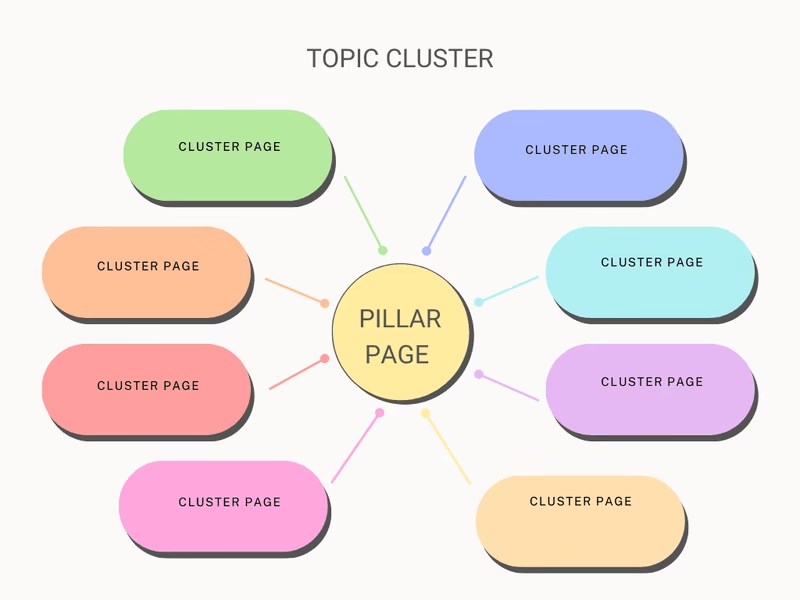In this post, you’ll learn what Content Clustering is, why it works, and exactly how to use it to boost your website traffic, even if you’re not an SEO expert.
If you’re trying to rank higher on Google in 2025, you need more than just keywords. You need Content Clustering. This simple but powerful SEO strategy is what separates websites that rank on page one from those stuck in digital darkness.
Let’s break it down.
What is Content Clustering?
Content Clustering means grouping related blog posts and pages around one main topic. That main topic becomes your pillar content, and the smaller posts that link back to it are called cluster content.
Think of it like a hub and spokes:
- The hub = your main guide (pillar content)
- The spokes = related articles (cluster content)
All the pieces are linked together. This tells Google that your site has deep knowledge about the topic.
Example:
- Pillar: “Instagram Marketing in Nigeria”
- Cluster posts: “How to Use Reels for Business in Nigeria,” “Top Hashtags for Nigerian Brands,” “Instagram Ads Cost in 2025”
This simple content clustering format helps Google understand your site’s structure and boosts your chances of ranking higher.
Why Content Clustering Works in 2025
SEO has changed. In 2025, search engines care about:
- Topic depth (not just keywords)
- User experience
- Internal linking
Content Clustering helps you tick all these boxes:
- Improves Topical Authority: Google sees you as an expert when you cover one topic in depth.
- Better User Navigation: Visitors stay longer and explore more pages.
- Stronger Internal Linking: You guide readers (and Google bots) through related content.
- Higher Rankings: Clusters help all posts support each other, lifting the whole group.
When done right, Content Clustering can help you dominate search results.
Also Read: The Social Media Posting Formula That Actually Works
How to Build a Content Cluster
Let’s go step by step. You don’t need any fancy tools to get started with Content Clustering.
Step 1: Choose a Broad Topic (Pillar Content)
Pick a main topic that your audience searches for often.
- Example: “Small Business Marketing in Nigeria”
Write a long, detailed guide on this topic. Make sure it’s useful and easy to read.
Step 2: Find Subtopics (Cluster Content)
Use Google, AnswerThePublic, and tools like Ubersuggest to find questions people ask around the topic.
Examples of clusters:
- “How to run Facebook Ads on a small budget”
- “What is WhatsApp Marketing?”
- “Email marketing tools for Nigerian businesses”
Step 3: Link Everything Together
Link each cluster post back to the pillar page. And link from the pillar to each cluster. This connection boosts SEO.
Step 4: Optimise for Keywords
Use your main keywords naturally in both pillar and cluster content. But don’t stuff them. Write for humans first.
Step 5: Update Regularly
Every 3–6 months, update both pillar and cluster content with fresh data and examples. Google loves updated content.
Sample Content Clustering Structure
Let’s say you run a food blog in Nigeria. Here’s how you could create a Content Clustering system:
Pillar Topic: Nigerian Jollof Rice Recipes
- Cluster 1: How to Cook Party Jollof in 30 Minutes
- Cluster 2: Best Pots for Cooking Nigerian Jollof
- Cluster 3: Tomato Stew Tips for Richer Taste
- Cluster 4: Why Jollof Rice Burns and How to Avoid It
Each post links to the main Jollof Rice guide, and the main post links to each cluster. This helps readers and search engines.
SEO Tools That Help with Content Clustering
You don’t need expensive tools to start. But here are a few that make Content Clustering easier:
- Surfer SEO – Helps outline pillar content and cluster suggestions.
- Frase – Great for content briefs and keyword clustering.
- Google Search Console – Check what’s already ranking and build clusters around it.
- Ubersuggest – Find related keywords for your clusters.
Common Mistakes to Avoid
Many people try Content Clustering and fail because they rush or miss key steps. Avoid these mistakes:
- Choosing broad or vague topics
- Not linking clusters back to the pillar
- Writing weak cluster content with no value
- Focusing only on keywords, not usefulness
- Giving up too early – SEO takes months.
If you stay consistent and helpful, Content Clustering will start showing results.
Conclusion
You don’t need to be an expert. You just need a smart system.
Start with one topic. Break it down into smaller helpful posts. Link everything. Update regularly. That’s how you win in SEO today.
Start using it today, and watch your rankings rise.
Don’t Miss: Does Email Marketing Still Work in 2025?





